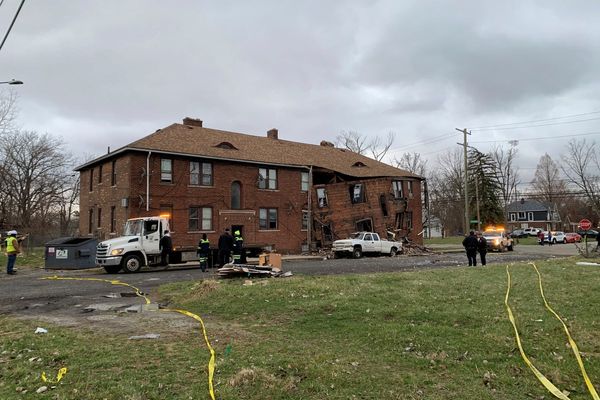
Two powerful earthquakes of magnitude 7.7 and 6.4 hit central Myanmar on Friday, causing death and large-scale destruction in both Myanmar and neighbouring Thailand.
Tremors were also felt elsewhere in the region.
On Saturday, Myanmar state media reported that at least 1,644 people had been confirmed dead while 2,376 have been injured. About 30 people are still missing.
The US Geological Service’s predictive modelling has estimated Myanmar’s death toll could rise above 10,000. Authorities in Myanmar have imposed a state of emergency in six states.
On Friday, the United Nations Secretary-General Antonio Guterres said the UN was mounting a response following a request from the Myanmar authorities.
“Our team in Myanmar is already in contact in order to fully mobilise our resources in the region to support the people of Myanmar,” Guterres said. “But of course, there are other countries impacted. The epicentre is in Myanmar, and Myanmar is the weakest country in this present situation,” he added.
By Saturday morning, other nations were rallying support. The Association of Southeast Asian Nations (ASEAN) released a joint statement from members’ foreign ministers, saying: “ASEAN affirms its solidarity and will work closely to coordinate humanitarian assistance, support and facilitate relief operations, and ensure timely and effective humanitarian response.”
The Chinese embassy in Myanmar said China would provide 100 million yuan ($13.77m) in aid, including tents, blankets, emergency medical kits, food and water. The first round of aid will arrive on March 31. South Korea pledged $2m in humanitarian aid, its foreign ministry said.
China, Russia and India are also among those sending rescue teams.
Here is everything we know about the disaster so far:
What happened in Myanmar?
At about 12:50pm (06:20 GMT) on Friday, an earthquake of magnitude 7.7 hit 16km (10 miles) northwest of Sagaing city at a depth of 10km (6 miles). This was followed by an aftershock of magnitude 6.4.
The earthquake’s epicentre was about 17km (11 miles) west of the country’s second-largest city, Mandalay, which has a population of nearly 1.5 million people.
Al Jazeera’s Tony Cheng was outside Myanmar’s Defence Services Museum in the capital, Naypyidaw, when the earthquake hit.
“Suddenly, the building started moving very heavily from side to side,” Cheng said. “Plaster was raining down.”
Cheng added that concrete from the roof and support columns of the portico also fell during the quake.
“The swaying went on for about 30 seconds to a minute,” he said. “It gained in intensity as it went on. I’ve been in earthquakes in this region before, and I’ve never felt anything as strong as that.”

Where else were the earthquakes felt?
The tremors were felt across Southeast and South Asia.
Thailand:
Ten people have died in Bangkok as a result of the earthquake, Bangkok’s Deputy Governor Tavida Kamolvej told Reuters on Friday evening.
Eight of the victims were killed when a 30-storey building that was under construction collapsed, also trapping 47 workers, according to the police and medics. Rescue workers said a further 117 people were missing.
The Stock Exchange of Thailand suspended activity on Friday afternoon.
Bangkok’s entire public transport system also was shut down for safety reasons, reported Al Jazeera’s Imran Khan, who was in the city when the quake struck.
“Traffic is absolutely gridlocked. The buildings have been shuttered in the centre of the city,” Khan said.
China:
China’s Xinhua news agency reported that shocks were felt in the southwestern province of Yunnan, which lies at the border with Myanmar. No casualties were reported.
Chinese media also reported that, in the northeast of the country, tremors were felt in Yunnan and Sichuan provinces in China, causing injuries and damage to houses in the city of Ruili on the border with Myanmar.
In Mangshi, a city about 100km (60 miles) northeast of Ruili, the shaking was so strong that people were unable to stand, one resident told The Paper, an online media outlet.
Tremors were also reported in Cambodia, India and Bangladesh.
What do we know about the victims in Myanmar?
Myanmar state media has reported that at least 1,644 people have been confirmed dead while 2,376 have been injured. About 30 people are still missing.
Reports of deaths and injuries have been coming in from around the country.
More than 50 mosques sustained damage during Friday prayers, according to the shadow National Unity Government, and hundreds of Muslims are feared to be among the dead.
Quoting a Red Cross official, AFP reported on Saturday that more than 90 people could be trapped inside the crushed remains of an apartment block in Mandalay in central Myanmar.
Two people were killed in the town of Taungoo in Myanmar when a mosque partially collapsed, the Reuters news agency reported, quoting witnesses. Local media also reported that a hotel collapsed in Myanmar’s southern city of Aungban, killing at least two people and injuring 20.
A doctor at a 1,000-bed general hospital in Naypyidaw told the AFP news agency that 20 people had died there. “About 20 people died after they arrived at our hospital so far. Many people were injured,” the doctor said on the condition of anonymity.
A rescue worker from the Moe Saydanar charity group told Reuters that 60 bodies had been retrieved from monasteries and buildings in Pyinmanar, near Naypyidaw, and more people were trapped.
“This 60 is only from my charity group and only at Pyinmanar town,” he said.
How bad is the damage?
Infrastructure has taken a heavy hit in Myanmar and Thailand. Buildings, bridges and roads have been destroyed, according to local media.
State media in Myanmar said buildings and structures, including more than 50 mosques which were hit during Friday prayers during the holy month of Ramadan, were damaged or had collapsed in multiple cities and towns. Pieces of the ceiling at the National Museum of Naypyidaw fell as the tremors shook the structure, AFP reported.
State media reported that a railway bridge and a road bridge on the Yangon-Mandalay Expressway collapsed.
Local media also reported that the Ma Soe Yane monastery had collapsed and the former royal palace had been damaged.
The 90-year-old Ava Bridge, also called Old Sagaing Bridge, partially fell into the Irrawaddy River, which flows between Mandalay and Sagaing.
In Thailand, operations at six airports, including Bangkok, Chiang Mai, Hat Yai, Chiang Rai and Phuket resumed on Saturday following safety checks.
How has the government responded?
Among the places where Myanmar’s military government has imposed a state of emergency are Mandalay and Naypyidaw.
On Saturday, Myanmar’s junta chief, Senior General Min Aung Hlaing, visited Mandalay near the epicentre of the quake. “The Chairman of the State Administration Council instructed authorities to expedite search and rescue efforts and address any urgent needs,” the junta said in a statement on state media, referring to Min Aung Hlaing.
A major hospital in the capital, Naypyidaw, has been declared a “mass casualty area”, an official at the facility told the AFP news agency. Rows of wounded were treated outside the emergency department of the 1,000-bed general hospital, some writhing in pain, others lying still as relatives sought to comfort them.
Zin Mar Aung, the country’s shadow foreign minister with the parallel National Unity Government, said troops from the anti-junta groups, known as the People’s Defence Forces, would provide humanitarian assistance.
“It’s very serious, we need humanitarian and technical assistance from the international community,” Zin Mar Aung told Reuters.
“The state will make inquiries on the situation quickly and conduct rescue operations along with providing humanitarian aid,” the government said in a message on the Telegram messaging application.
What’s the latest on the ground?
Rescue efforts are under way. However, the Red Cross said damaged power lines in Myanmar are impeding rescue teams from reaching Mandalay and Sagaing.
The Red Cross said initial reports suggested the quake has caused “significant damage” and “information on humanitarian needs is still being gathered.”
Bangkok Governor Sittipunt has warned of possible aftershocks but has asked people to remain calm, saying the situation is under control.

Why is Myanmar particularly vulnerable?
Myanmar lies along the Sagaing Fault, a tectonic boundary between the Indian Plate and the Burma microplate, making it seismically active.
The country is also one of Asia’s poorest and least prepared for large-scale disasters. The country has urbanised rapidly, but the construction of buildings in cities has not accounted for seismic risks. The buildings in cities including the largest, Yangon, were not designed to be earthquake resistant, making them more vulnerable to damage from tremors, according to the United Nations Development Programme.
After a 2021 military coup, in which the military seized power, Myanmar became embroiled in a civil war and has been isolated internationally, making rescue efforts difficult. However, leaders from India, France and the European Union have offered support.







